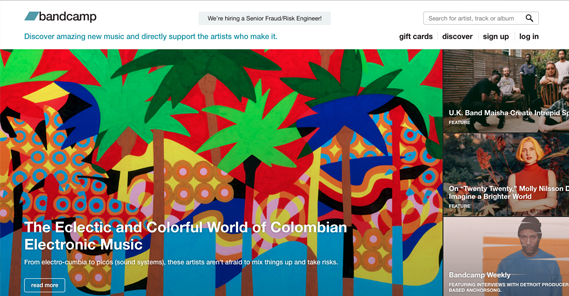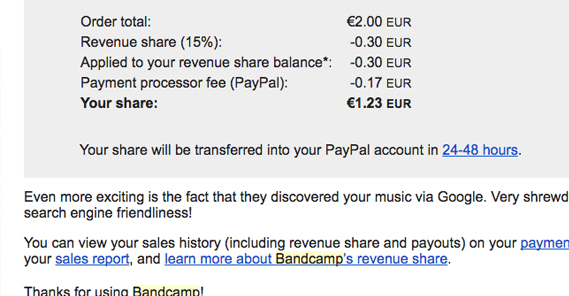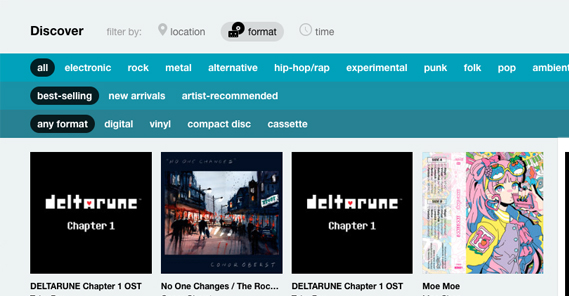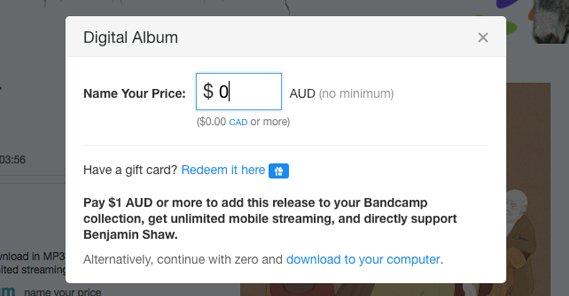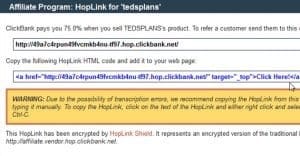18 Ways to Promote and Sell Your Music on Bandcamp

Bandcamp is a global platform for hosting and selling music, used predominantly by small independent musicians. It’s excellent for its purpose, but it’s also a crowded platform. How can you make effective use of Bandcamp for music promotion? Let’s talk about it.
About Bandcamp
Using Bandcamp is free and pretty easy for musicians and artists. Sign-up is a quick and painless process, as is uploading music. Music fans can create accounts and follow individual artists, maintain wishlists, and explore similar music to what they already like. Artists can sell directly, with complete control over pricing and how accessible the music is to stream. I’ve seen some albums available on Bandcamp with unlimited streaming, and others that only allow each track to be played 2-3 times before it’s locked behind a purchase. Bandcamp also works directly with some music labels, and it can be a great discovery platform.
Since we’re talking about selling music, I’m going to look at things from the perspective of an artist looking to sell. So here’s what Bandcamp offers musicians:
- Easy accessibility for fans. The website and mobile apps allow unlimited streaming of purchased music in high quality formats.
- Total control. You can charge any price and change prices whenever. You can charge a minimum price and let users pay more if they choose. You can even require nothing more than an email address.
- Global availability. Bandcamp accepts 18 different currencies from around the world.
- Analytics. Bandcamp offers fairly rich analytics about links to albums, music embeds, track popularity, purchasing, search terms, and more.
- Product sales. You can bundle music sales with physical items, ranging from CDs or vinyl to apparel to whatever else you want to sell. You can even sell tickets to your shows directly through Bandcamp.
- Chart access. Bandcamp submits sales reports to several global music charts, meaning you can place on them if you’re popular enough.
- Search engine visibility. Everything is indexed, so band names, lyrics, and song titles can all show up on Google’s results page.
- Album codes. Artist accounts come with the ability to generate 200 codes for free albums to send out and give away. You earn more by selling, an additional thousand codes for every $500 in sales, or you can purchase more directly for a few cents each.
- Customizable band and album pages. You can make your pages look pretty dang slick with minimal effort.
Plus, of course, there’s the element of trust. Bandcamp is a trusted platform that processes millions of dollars in payments on a monthly basis. Users know that if they pay for something on the platform, they’ll get it.
The only major downside to Bandcamp is them taking a cut of the profits off any album sold. That’s not a big surprise, though; every platform and every record label, manager, and anyone else involved in selling music is going to want their cut. Bandcamp only takes 15% of digital sales and 10% of merch sales, which decreases once you top $5k in total sales. That’s a lot less than a lot of other alternatives.
Bandcamp also has a Pro version, for artists who want to pay a fee to gain access to additional features.
- Batch uploads, to queue up uploading an entire album + assets all at once instead of track by track.
- Messaging to reach fans, with geographic targeting and other features.
- Private streaming organization, you can send invites to specific people via email, message, or any other contact method, and stream to a DIY audience.
- Video hosting without ads.
- A custom domain name for your Bandcamp profile page.
- More advanced analytics, and Google Analytics integration.
- The ability to disable streaming for specific tracks.
All of this comes at the cost of $10 per month, which is pretty reasonable if you’re getting any sales at all from the platform. Which, if you follow the tips I’ve accumulated below, you should be!
Tips for Bandcamp Success
I’m going to divide up these tips into a few categories to make things simpler. For example, this first category is off-site benefits.
You want to establish a presence outside of Bandcamp, because no one platform alone (except maybe Facebook) can reach enough people to become a great success.
- Build a website. You want at least one web presence that you 100% control on your own. You can do it through a website builder like Squarespace, you can set up a WordPress template and run on a cheap web host, you can pay for a web developer and set up a custom site, it doesn’t really matter. What matters is that you have a bandname.com URL people can use to find you and find information about your band, your show dates and locations, your albums, and so on.
- Build social media profiles. Social media is how millions of people interact with the bands, brands, and people they want to engage with on a daily basis. At the bare minimum, you should have a Facebook band page and a Twitter profile. You might also consider an Instagram account, possibly something like Snapchat, and – depending on how modern savvy you are – something like one of the new platforms, like TikTok.
- Build a mailing list. It might seem strange for a band to keep an email newsletter going, but a mailing list is a great way to ensure your fans always know when you’re touring, playing shows, or releasing new music. You don’t have to rely on going viral or reaching the front page of some suggested music feed; you have your fans already at your fingertips. It’s pretty simple to set up something like Mailchimp to maintain a list and send out a new newsletter once a month.
- Run a blog. Much like a newsletter, you don’t often think of a blog when you think of a band, but a blog can go a long way towards increasing visibility. You don’t have to write frequently, even once a month is fine; just enough to keep fans aware of what you’re doing and remind people you’re alive. Share stores of being on the road, of composing, of performing, or even just life. Your fans won’t complain.
- Set up your Bandcamp pages. Bandcamp is very easy to get up and running, and you can customize your album pages with colors and uploaded imagery quite nicely. Do so, and make sure to upload your albums and configure them properly. Writing album descriptions, uploading album covers, and a proper credits section are all quite useful for helping your music stand out.
Once you have your presence established, you need to get down to optimizing your presence on Bandcamp. One element too many musicians miss is the opportunity to optimize the little details that can have a big impact.
Specifically, these details can help you reach the Discovery section of Bandcamp, which means front page exposure and a lot of new listeners.
- Choose a Main Genre and Sub-Genres. You have to understand your own music and, more importantly, the way others categorize your music. Maybe you feel like “Acoustic” as a genre fits you, but if most people think of you as Folk, you want to tag yourself as Folk so you can show up in those searches. Your choice of Main Genre is incredible important, as you can only have one, and it dictates your sub-genre choices as well. If you try to pick sub-genres that are outside of the main genre, you get zero visibility for them. Make sure to do plenty of research, and consider reading up on some case studies for ideas of how the Bandcamp algorithm works.
- Pick a geographic location. Bandcamp’s Discover section has city sections in it, but only a limited selection of cities. Browse through their available cities and see if one of them is close to you. If it is, choose that as your home city. It’s ideal if you can visit the city on a regular basis, particularly for tours and establishing a presence. Then, if you take off, you can be one of the top musicians in your genre in that city, which is a great jumping off point for future gigs, bookings, local press, and other benefits. It’s also why you shouldn’t choose a city you can’t visit; what if they want to interview you, see your studio, or have you perform, but you chose a city across the country?
- Pay attention to your album art. Album art is quite important, as it’s an introduction to your album and your aesthetic. People choose whether or not to tap on something from the discovery queue based on imagery, since there aren’t audio previews. You should also make sure your album art works at a small scale, since a lot of users will be seeing a scaled-down version of it displayed on a smartphone screen. If your art loses a lot of fine detail, you lose out on those potential listeners.
- Specify your lyrics. If your songs have lyrics, that is. I know a lot of musicians use ambient and electronic or even just instrumental music as the basis of their albums, with lyrics a rarity. Still, any song that has lyrics, you should upload the accurate, proof-read, typo-corrected lyrics. This helps you show up in Google search for the lyrics whenever someone wants to find a song they half-remember, plus it fills out your album page and allows users to follow along with the song more accurately.
- Choose your pricing. I don’t have a wealth of pricing data available, but you should be able to see what prices have worked the best in the past, and you can do some research into recommendations from other successful artists. One great recommendation, though, is enable flexible payments. If you set a minimum at $5 for an album but allow users to pay more than the minimum if they want to support you, chances are a sizable number of users will. Bandcamp themselves say a whopping 50% of purchasers pay more than the minimum when they buy, and I’ve done it myself.
- Use image maps for links. Bandcamp allows you to put an image map on your page header. This converts sections of the header image into clickable links. Design your header to include symbols or words that call out your website, social profiles, storefront for merch, tour dates, and any other critical pages. Then use the image map to map links to those pages on the relevant parts of the image. Essentially, you’re making top-bar navigation out of a header image.
Now let’s get into a few of the more traditional marketing tips that help bring users to your page.
Then we can convert those users into paying customers.
- Take advantage of your free album copies. As I mentioned above, Bandcamp gives you a handful of codes for free copies of your album. Run contests and giveaways, reward band ambassadors, and send previews to influencers to make the most of these codes.
- Share new music posts, blog posts, and newsletters on social media. Bandcamp’s algorithms aren’t quite as focused on traffic as other social networks and storefronts, but more traffic means more listeners, more listeners means more buyers, and more buyers means more chance to end up on best seller lists in your genre and in your city. It can’t be overstated: ending up on a discover list is one of the best things that can happen to an artist on Bandcamp. It opens a lot of doors.
- Offer discount codes. Discounts on an album you release, which go directly to your newsletter, reward your fans. This works quite well in conjunction with flexible pricing; many users will pay full price or more, even with a discount code!
- Learn your listener persona. Who is listening to your music? More importantly, who is paying for your music? Learn about those people, and use that knowledge to adjust your imagery to appeal specifically to them. Be cynical about it, and don’t be afraid to sell out. Everyone needs to eat.
- Consider split testing. Split testing is when you run one option for a while, see how it works, then run an alternative and compare the results. You can split test album imagery and tags on your albums in an ongoing process to capture the most attention. Unlike more chronologically-focused social networks, Bandcamp will happily throw a years-old album in the discovery queue for a new tag just added to it.
- Make sure your content is high quality. Very high quality audio recordings can be downscaled for streaming, but please the audiophiles amongst your audience. There’s no reason not to upload high quality masters.
- Consider applying for PayPal’s micropayments. Since Bandcamp is likely a lot of small payments, the PayPal fees can eat up a lot of your potential profits. Micropayments allow you to process low-value transactions at a lower cost.
What are your favorite or most successful ways you’ve sold your music on Bandcamp? Let us know in the comment section to share with others!
 ContentPowered.com
ContentPowered.com
